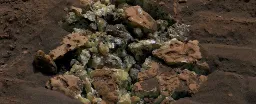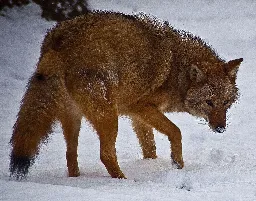Science
- Wild sharks off Brazil coast test positive for cocaine, scientists saywww.theguardian.com Wild sharks off Brazil coast test positive for cocaine, scientists say
Latest research shows how illegal drug consumption by humans is harming marine life

Wild sharks off the coast of Brazil have tested positive for cocaine, according to new study by Brazilian scientists, in the latest research to demonstrate how illegal drug consumption by humans is harming marine life.
According to a study entitled Cocaine Shark and published in the journal Science of the Total Environment, scientists dissected the bodies of 13 sharpnose sharks (Rhizoprionodon lalandii) caught in fishermen’s nets off a beach in Rio de Janeiro.
All 13 tested positive for the drug.
Previous studies have found cocaine in river, sea and sewage water, and traces of the drug have been found in other sea creatures such as shrimps.
A separate study recently revealed that high levels of cocaine residue were causing “serious toxicological effects” in animals such as brown mussels, oysters and eels in Santos Bay, in the Brazilian state of São Paulo.
But the concentration found in the Rio sharks was 100 times higher than had been found in other marine animals, the researchers said.
How the cocaine ended up in the sharks remains a mystery.
- This Giant Cosmic 'Butterfly' Is a Planet-Forming Diskwww.smithsonianmag.com This Giant Cosmic 'Butterfly' Is a Planet-Forming Disk
New research has confirmed that the celestial object may be the biggest of its kind ever found
/https%3A%2F%2Ftf-cmsv2-smithsonianmag-media.s3.amazonaws.com%2Ffiler_public%2Fac%2F67%2Fac6788b0-1d73-44f2-b968-a319ff7679e3%2Fbigger_main_image_large.jpg?format=webp&thumbnail=256)
- Missed the Auroras in May? Here’s How to See Them Next Timewww.smithsonianmag.com Missed the Auroras in May? Here’s How to See Them Next Time
Three veteran aurora chasers and a NASA scientist share everything you need to know to check these dazzling displays off your bucket list
/https%3A%2F%2Ftf-cmsv2-smithsonianmag-media.s3.amazonaws.com%2Ffiler_public%2F47%2Fed%2F47ed2f31-f77b-4c3f-a20a-574bc1a8c214%2Fsinha2_aurorasaurus_pho_20240411.jpg?format=webp&thumbnail=256)
- How Do We Know When to Pee?www.smithsonianmag.com How Do We Know When to Pee?
The basic urge is surprisingly complex and can go awry as we age
/https%3A%2F%2Ftf-cmsv2-smithsonianmag-media.s3.amazonaws.com%2Ffiler_public%2F18%2F66%2F186616cb-4800-471a-b199-f546735811a3%2Fgettyimages-643755291_web.jpg?format=webp&thumbnail=256)
- Curiosity Cracked Open a Rock on Mars And Found a Huge Surprisewww.sciencealert.com Curiosity Cracked Open a Rock on Mars And Found a Huge Surprise
A rock on Mars has just spilled a surprising yellow treasure after Curiosity accidentally cracked through its unremarkable exterior.

- Debate: "200 Proofs the Earth is not a Spinning Ball"www.slideshare.net 200 proofs the earth is not a spinning ball
200 proofs the earth is not a spinning ball - Download as a PDF or view online for free

You can't disprove flat earth theory... or can you?
- Ants may be the only animal that performs surgical amputations
In his 11 years studying ant behavior, biologist Erik Frank had never seen anything like it. He and his colleagues at the University of Würzburg brought Florida carpenter ants back to their lab in Germany to learn how they respond to injury. Most ant species treat the injured or severed limb of a comrade by coating it with an antimicrobial goo. But the reddish-brown carpenter ants took a different tack: They bit the remainder of the limb off, effectively amputating it.
Other animals, such as lizards, shed their own limbs to escape predators, but Frank says this is the first case of an insect severing the leg of a nestmate to save its life. The only other species that does this is humans. “I didn’t believe this at all because it was very counterintuitive,” he says. “I repeated the experiment four times before I accepted it.”
- Why this summer’s forecast is bad news for the US after an exceptionally disastrous start to the yearedition.cnn.com Why this summer’s forecast is bad news for the US after an exceptionally disastrous start to the year | CNN
The US has been rocked by an extraordinary number of weather disasters this year with a staggering price tag. Forecasters say it could get worse in summer.

The United States has been rocked by an extraordinary number of tornadoes and devastating storms this year that have already left a staggering price tag.
Now heading into what forecasters say will be an extreme summer – from punishing heat waves to severe weather and hurricanes – the nation’s disaster relief agency is expected to run out of money before it’s even over.
The US has been thrashed with 11 extreme weather disasters with costs exceeding $1 billion so far this year, with a total price tag of $25.1 billion, according to an updated tally from the National Oceanic and Atmospheric Administration. It’s tied for the second-most such disasters on record and doesn’t even include the extreme weather in the second half of May, said Adam Smith, an applied climatologist with NOAA.
...
FEMA’s tenuous balance sheet reflects how many destructive storms have already lashed the US.
This spring produced the second-most tornadoes to-date since records began in 1950, according to the Storm Prediction Center. Tornado activity skyrocketed from late April through May, with more than 780 confirmed tornadoes cutting across the central and eastern US during April and May, the SPC said.
...
A chorus of expert voices are calling for an above-average Atlantic hurricane season as anxiety-inducing conditions in the atmosphere and oceans align. Record-breaking ocean heat is expected to feed hurricanes, helping them form, strengthen and survive. El Niño is predicted to give way to La Niña and create more favorable atmospheric conditions for storms to thrive.
Just about every kind of extreme weather is possible during summer, including more severe thunderstorms. June is the third-most active month for tornadoes in the US, according to the SPC. It’s also the most-active month for destructive and costly severe hail, a 2012 study found.
- Elephants may refer to each other by namearstechnica.com Elephants may refer to each other by name
The animals seem to respond more actively to calls that include their "name."

Lots of animals communicate with each other, from tiny mice to enormous whales. But none of those forms of communication share even a small fraction of the richness of human language. Still, finding new examples of complex communications can tell us things about the evolution of language and what cognitive capabilities are needed for it.
On Monday, researchers reported what may be the first instance of a human-like language ability in another species. They have evidence that suggests that elephants refer to each other by individual names, and the elephant being referred to recognizes when it's being mentioned. The work could benefit from replication with a larger population and number of calls, but the finding is consistent with what we know about the sophisticated social interactions of these creatures.
...
he researcher worked with recordings of elephant calls made in three distinct social contexts. One was a contact call, made when a group member is far enough away that they are no longer visible and was used to re-establish contact. A second is greeting calls, which are made when an individual approaches another. And the third was a caregiving call given to young offspring within the group. Calls were used for analysis if the researchers could clearly identify a recipient of the call.
The rumbles elephants produce are harmonically complex, and it's difficult to identify important features by looking over things like frequency plots. So, the researchers used two methods of examining them. One was a machine-learning approach called a random forest model that can be used for classification tasks. Separately, they used audio analysis software to identify the degree to which any two calls share common features.
Once the system was set up, it correctly identified the recipient in over a quarter of the calls analyzed, much higher than would be expected based on random chance. That may seem low, but recall that it may not always be necessary to call out an individual's name each time you communicate with them.
The researchers also analyzed calls from one individual directed toward another. They had higher levels of similarity to each other than they did to any calls to different individuals. This was true regardless of social relationships among the individuals or the context in which the call was being made. Social context also mattered as it was easier to detect names in contact and caregiving contexts.
- Florida shark attacks: Woman and two girls injured at beacheswww.bbc.com Florida shark attacks: Woman and two girls injured at beaches
One woman was said to have had part of her arm amputated after being bitten, while two girls were also attacked.

Beachgoers in the Gulf Coast of Florida have been told to be vigilant, after three swimmers were attacked by sharks in two separate attacks.
One woman was said to have had part of her arm amputated after being bitten on Friday in Walton County in north-west Florida.
Less than two hours later, at another beach four miles further east, two teenage girls were in waist-deep water with friends when they were attacked.
One of the girls suffered "significant injuries to the upper leg and one hand" while the other had minor injuries on one of her feet, fire officials said.
- Blog Post on Biological and Behavioural Changes Caused by Hormonal Contraceptionwww.raweggstack.com STUDY ANALYSIS: The Pill and Women's Brains II
A new study suggests an even greater depth to the biological and behavioural changes caused by hormonal contraception
"The Pill" may be negatively impacting and altering women's mental lives.
>The authors of that study explained how hormonal birth control appears to shrink an important region of the brain, the ventromedial prefrontal cortex, that’s associated with fear and emotional processing more broadly.
>>In our study, we show that healthy women currently using COCs had a thinner ventromedial prefrontal cortex than men.
>>This part of the prefrontal cortex is thought to sustain emotion regulation, such as decreasing fear signals in the context of a safe situation. Our result may represent a mechanism by which COCs could impair emotion regulation in women.
>What the researchers found was that the ventromedial prefrontal cortex in women who were currently using COCs was significantly thinner compared to men.
>Interestingly, this reduced thickness was not observed in women who had discontinued use of COCs in the past. This suggests that the behavioural changes may be reversible if use of the Pill ceases.
>The possibility that this thinning effect might be reversible is the only potential silver lining to this study, which otherwise suggests that the Pill really may be having profound effects on the behaviour of the tens of millions of women—and hundreds of millions worldwide—who take it.
- Human brain cells hooked up to a chip can do speech recognitionwww.technologyreview.com Human brain cells hooked up to a chip can do speech recognition
Clusters of brain cells grown in the lab have shown potential as a new type of hybrid bio-computer.
Brain organoids, clumps of human brain cells grown in a dish, can be hooked up to an electronic chip and carry out simple computational tasks, a new study shows.
Feng Guo and his team at Indiana University Bloomington generated a brain organoid from stem cells, attached it to a computer chip, and connected their setup, known as Brainoware, to an AI tool. They found that this hybrid system could process, learn, and remember information. It was even able to carry out some rudimentary speech recognition. The work, published today in Nature Electronics, could one day lead to new kinds of bio-computers that are more efficient than conventional computers.
Scientists have been trying to build computers based on advanced biological systems for decades. Guo says that such computers could overcome some challenges of silicon-based computers, such as bottlenecks in data processing.
Conventional computers are much better than brains in dealing with numbers, but human brains are better at processing complex information while using relatively little energy. “This is a first demonstration of using brain organoids [for computing],” says Guo. “It’s exciting to see the possibilities of organoids for biocomputing in the future.”
- Delhi sizzles: One station records 52.9°C, Met dept says checking data and sensorsindianexpress.com Delhi sizzles: One station records 52.9°C, Met dept says checking data and sensors
The same station had recorded 49.9 degree Celsius on Tuesday, an all-time high for Delhi.
>THE MUNGESHPUR weather station in Delhi recorded a maximum temperature of 52.9 degree Celsius on Wednesday, an all-time record for any location in India, prompting the Met office to rush its scientists to check the authenticity of the reading.
>The Safdarjung weather observatory, which serves as the marker for the entire city, registered a maximum temperature of 46.8 degree Celsius on Wednesday, the highest in 80 years. It was six degrees higher than the normal expected at this time of the year, and the highest that the station has recorded since 1944. But it was substantially lower than the temperature at Mungeshpur, located on the northern outskirts of Delhi, bordering Haryana.
>“The maximum temperature over Delhi NCR varied from 45.2 degree Celsius to 49.1 degree Celsius in different parts of the city. Mungeshpur reported 52.9 degree Celsius as an outlier compared to other stations. It could be due to an error in the sensor of local factors. IMD is examining the data and sensors,” the India Meteorological Department said in a statement.
This is not a story denying the heatwave in Delhi but rather about how one particular station for measuring temperatures may have been a bit off... Or maybe not.
After all, other palces were getting it right:
>Najafgarh station recorded 49.1 degree Celsius, the highest for any Delhi observatory on Wednesday, while Pusa Road recorded 49 degree Celsius.
- Why Canada is riddled with wildfires that burn year-roundwww.bbc.com Why Canada is riddled with wildfires that burn year-round
A rise in zombie fires in Canada is having knock-on effects for the wildfire season. Researchers and fire services are racing to find ways to put out perennial fires.
Even at -40C (-40F), smoke kept billowing from under the snow. All through the winter, Marty Wells, a wolf trapper and fire crew leader, would see plumes of white as he drove north out of Fort Nelson, British Columbia in Canada. He found melt holes venting like hot springs, and flames licking at the foot of white-encrusted trees in the muskeg bogs. In places the ground was burning a foot (30cm) deep or more.
"It gets in the muskeg and burns the muskeg and then it crawls, it creeps underground is what happens, and then pops up somewhere else," Wells says.
When the snow melted in early May, these smouldering fires, often called "zombie" fires, came to life again and began to feed on dry trees and brush. The plumes of smoke north of Fort Nelson became a conflagration of 700 sq km (270 sq miles). The town is now caught in a horseshoe of fire: to the east, another zombie fire has burned an even larger area, while to the west, a new wildfire has encroached to within 2.5km (1.6 miles) of the community, damaging properties. Residents have been evacuated. Wells says he didn't expect the fire to get this bad. "It just happened that day that we had really high winds and right conditions and away it went."
Canada's boreal zone – a mixture of forest and wetlands – makes up more than half of its land area. Wildfires burned a record 185,000 sq km (71,429 sq miles) of the country in 2023, an area the size of Syria. In western Canada, many of these fires went underground and smouldered until this spring, which fire services refer to as "overwintering" or "holdover" fires.
Much of Canada is in its third year of drought, with the western provinces of Alberta, British Columbia and the Northwest Territories the worst hit. Snowpack, the main source of water, was 37% lower than normal in British Columbia this winter, and powerful rivers shrivelled into thin veins of blue. As the snow melted and windy weather arrived to fan the flames in April and May, these zombie fires tore into a smorgasbord of dry fuel. With hotspots flaring up around old burn areas in north-west Alberta, the province had to declare an early start to the fire season on 20 February, rather than the usual 1 March.
Mike Flannigan, a professor of wildland fire at Thompson Rivers University in British Columbia who has been monitoring fires there since the 1970s, says he's never seen an outbreak of zombie fires like this one. "This year, it's extremely significant," he says. "British Columbia has hundreds of thousands of hectares burned, and most of those are due to overwintering fires."
Scientists believe that zombie fires are becoming more common, and that they are a symptom of the growing frequency and intensity of wildfires due to human-caused climate warming. But these fires also kick off the fire season earlier and could potentially result in more carbon emissions per area burned.
- How cockroaches spread around the globe to become the pest we know todayapnews.com How cockroaches spread around the globe to become the pest we know today
A new study tracks how cockroaches spread around the globe to become the survival experts we know today.

- Ukraine war forced eagles to change migration routewww.bbc.com Ukraine war forced eagles to change migration route
Scientists believe they avoided perils including artillery fire on their way to their traditional breeding ground.
Eagles changed their migration routes across Ukraine to avoid fighting and because their habitats were likely damaged or destroyed by war, say scientists.
The researchers believe the Greater Spotted Eagles skirted around dangers including artillery fire, jets and tanks as well as buildups of troops.
They fly through Ukraine every Spring on their way from Greece and The Sudd - a large wetland in South Sudan - to breeding grounds in Belarus.
The scientists studied GPS data from tagged birds in the months after the February 2022 invasion, a time of heavy fighting in northern Ukraine as Russia tried to take Kyiv by sending troops south from Belarus.
- The mystery over why human brains have shrunk over timewww.bbc.com The mystery over why human brains have shrunk over time
The brains of modern humans are around 13% smaller than those of Homo sapiens who lived 100,000 years ago. Exactly why is still puzzling researchers.
The brains of modern humans are around 13% smaller than those of Homo sapiens who lived 100,000 years ago.Exactly why is still puzzling researchers.
Traditionally our "big brain" is thought to be what sets our species apart from other animals. Our capacity for thought and innovation allowed us to create the first art, invent the wheel, and even land on the Moon.
Certainly, when compared with other animals of a similar size, our brains are gigantic. The human brain has nearly quadrupled in size in the six million years since our species last shared a common ancestor with chimpanzees. However, studies show this trend toward larger brains has reversed in Homo sapiens. In our species, average brain sizes have shrunk over the course of the last 100,000 years.
For example in a recent 2023 study, Ian Tattersall, a paleoanthropologist and curator emeritus with the American Museum of Natural History in New York City, tracked the braincase volumes of ancient hominins through time. He started with the oldest known species, and ended with modern humans.
He found that rapid brain expansion occurred independently in different species of hominins, and at different times across Asia, Europe and Africa. Species whose brains grew over time include Australopithecus afarensis, Homo erectus, Homo heidelbergensis, and Homo neanderthalensis.
However, the trend for brain enlargement over time was turned on its head with the arrival of modern humans. The skulls of men and women today are on average 12.7% smaller than that of Homo sapiens who lived during the last ice age.
"We have very peculiarly shaped skulls, so early humans are very easy to recognise – and the very first ones have extremely large brains," says Tattersall.
Tattersall's finding replicates those of others. For example in 1934, Gerhardt Von Bonin, a German-born scientist affiliated with the University of Chicago at Illinois, wrote that "there is a definite indication of a decrease [in the human brain] at least in Europe within the last 10,000 or 20,000 years."
So how can we explain this striking reduction? Tattersall suggests that the shrinkage in brain size began around 100,000 years ago, which corresponds to a period of time in which humans switched from a more intuitive style of thinking to what he terms "symbolic information processing" – or thinking in a more abstract way to better understand your surroundings.
"This was the time when humans began producing symbolic artefacts and engravings with meaningful geometric images," says Tattersall.
Tattersall believes that the catalyst that caused this change in thinking style was the spontaneous invention of language. This led to the neural pathways of the brain being reorganised in a more metabolically efficient way, allowing humans to get more "bang for their buck".
In other words, as smaller and better organised brains were able to perform more complex computations, metabolically expensive larger brains simply became unnecessary.
- What your face says about how you’ll vote in the electionwww.telegraph.co.uk What your face says about how you’ll vote in the election
Square-jawed people are more likely to have Right-wing views, researchers suggest

- The El Niño weather pattern is having devastating effects in South Americawww.wyso.org The El Niño weather pattern is having devastating effects in South America
Unusually dry weather has led to water rationing and even power cuts. Colombia's capital city of Bogotá is rationing water for the first time in decades.
The weather pattern known as El Nino is having devastating effects in South America. Unusually dry weather has led to water rationing and even power cuts. Colombia's capital city of Bogota is now rationing water for the first time in decades. Manuel Rueda has a story.
...
MANUEL RUEDA, BYLINE: Steven Ramos (ph) runs a coffee shop outside el Externado, a large university in Bogota. But today there's no tap water, so he can't use his espresso machine. Instead, Ramos makes filtered coffee for his customers using a large bottle of water.
STEVEN RAMOS: (Speaking Spanish).
RUEDA: "Many people aren't going to their offices or to the university on the days without water," he says. "So my sales are suffering."
(SOUNDBITE OF VEHICLE RUMBLING)
RUEDA: Officials in Colombia's capital began to ration water this month by dividing the city into nine areas that are cut off from the water supply on a rotating basis. The drought has depleted local reservoirs and officials are trying to limit water consumption to give them time to recover.
NATASHA AVENDANO: It's been very dry and very hot.
RUEDA: Natasha Avendano runs Bogota's water company, the EAAB.
AVENDANO: Both things have led us to have higher levels of evaporation of water. And of course, people consume more water because it's been very, very hot.
RUEDA: To reduce consumption, Bogota officials aren't just rationing water, they're also asking people to change their habits.
AVENDANO: No car washing, no floor washing. We need to take care of every drop of water.
(SOUNDBITE OF BIRD TWEETING)
RUEDA: Climate experts say the dry weather in Bogota and much of Colombia is due to warming temperatures in the Pacific Ocean, which are known as El Nino events. This weather pattern happens every two to seven years. And it can have drastic effects around the world, especially in South America says Andrea Devis, an oceanographer in Bogota's Rosario University.
ANDREA DEVIS: We have a lot of rain along the coast during El Nino, the Pacific rains a lot. But on the other side of the Cordillera, we don't have any rain because all the rain was poured in the Pacific Coast.
RUEDA: The current El Nino event began last June. In Chile, dry weather contributed to forest fires in February. And in Ecuador, officials declared a state of emergency last week and began to ration electricity because of the lack of rainfall. Seventy-five percent of Ecuador's electricity comes from hydroelectric plants, but the dams in the mountains are at historic lows.
- Scientists Are Trapping CO2 And Turning It Into Stonewww.sciencealert.com Scientists Are Trapping CO2 And Turning It Into Stone
Researchers have turned carbon dioxide (CO2) into solid rock by injecting volcanic basalt rock with pressurised liquid CO2, and letting natural chemical reactions trigger the transformation.

Researchers have turned carbon dioxide (CO2) into solid rock by injecting volcanic basalt rock with pressurised liquid CO2, and letting natural chemical reactions trigger the transformation.
The technique, which takes two years to achieve, gives scientists another option for capturing and storing the excess CO2 humans are pumping into the atmosphere – and could one day be scaled up to take significant levels of carbon out of circulation.
The research was conducted by a team from the the US Department of Energy's Pacific Northwest National Laboratory (PNNL), and builds on a similar experiment in Iceland earlier this year, which dissolved CO2 in water and injected it into a basalt formation.
In the latest study, undiluted CO2 was used, and much more of it was stored at once: 1,000 tonnes of fluid carbon dioxide.
The PNNL team had already shown that the chemical reactions could happen in lab conditions, but until now, they didn't know how long the reactions would take in a real-world setting.
"Now we know that this mineral trapping process can occur very quickly, it makes it safe to store CO2 in these formations," says researcher Pete McGrail. "We know now that in a short period of time the CO2 will be permanently trapped."
- Lyrid meteor shower 2024: When, where & how to see itwww.space.com Lyrid meteor shower 2024: When, where & how to see it
Viewing opportunities could be hindered by the almost full moon close to the shower's peak.
- Great American Eclipse: April 8, 2024 (Anticipation Post)www.greatamericaneclipse.com Great American Eclipse
A total solar eclipse is coming to America on April 8, 2024. Find maps, videos, how to view, best places to go, eclipse glasses, and more.
> On April 8, 2024, the shadow of the Moon will cross Mexico, the United States, and Canada. This spectacular total solar eclipse will amaze many millions of people. This is sure to be a record-setting astronomical event.
Anyone in the path of totality or if not planning to watch or excited for this eclipse event passing through America in a couple days?
- New Study Strengthens Link Between Air Pollution, Depressionwww.psychologytoday.com New Study Strengthens Link Between Air Pollution, Depression
Does air pollution lead to late-life depression?
For years, various studies have probed the links between air pollution and risk for diseases, especially heart and lung issues. More recently it’s been shown that people inhaling higher levels of air pollution may also be at higher risk for brain conditions like Alzheimer’s, worse decision-making, and depression.
Now one of the largest studies to date has focused on the connection between several forms of air pollution and the risk for developing late-life depression, with concerning results.
The paper, published in February in JAMA Network Open, tracked almost 9 million Medicare participants in the United States to look at the relationship between air pollution and the risk for developing depression in subsequent years. In this cohort study, researchers plotted people’s geographically-determined exposure to three separate air pollutants—PM2.5, nitrogen dioxide, and ozone—and then watched to see who was diagnosed with depression.
Because the participants in this study were enrolled in Medicare, they were all at least 64 years old at the time they began the study (the average age was around 74). The population was 57% females. Additionally, in order to minimize the chances that people’s depression was a pre-existing issue, they didn’t start tracking new cases of depression until five years after people began the study.
At the conclusion of this study, the researchers found that all three forms of air pollution individually and in combination correlated with an increased risk for developing depression. It was notable that among the three air pollutants, higher levels of ozone exposure had the strongest link to developing late-life depression.
This study was certainly not the first to point out the association between mental health and air pollution exposure. However, the large sample size and differential categorization of the effects of the three different air pollutants make it relatively unique. It’s important to note that scientists aren’t fully certain as to the biological mechanisms that connect depression and air pollution, but activation of inflammatory pathways in the brain is a leading possibility.
Inflammation, once considered more an acute rather than chronic threat, has in recent years emerged as a potential driver of a wide variety of neurological and psychological conditions. Within the brain it's thought that inflammation could lead to a number of damaging effects including problems with neuron health as well as an unhealthy activation of immune cells called microglia.
Specific to air pollution, animal research has demonstrated that inhaled pollution significantly increased brain inflammatory markers, suggesting a lung-brain inflammatory mechanism. This is consistent with findings in humans. For example, in one 2016 study, researchers looked at brains of people after death and found that those exposed to more significant air pollution demonstrated higher levels of inflammatory markers in multiple parts of the brain including the prefrontal cortex and hippocampus, two areas linked to Alzheimer's and depression symptoms.
- ‘Artificial sun’ sets record for time at 100 million degrees Celsius in latest advance for nuclear fusionedition.cnn.com ‘Artificial sun’ sets record for time at 100 million degrees Celsius in latest advance for nuclear fusion | CNN
The Korean Institute of Fusion Energy announced a new world record for the length of time it managed to sustain temperatures seven times hotter than the sun’s core

Scientists in South Korea have announced a new world record for the length of time they sustained temperatures of 100 million degrees Celsius — seven times hotter than the sun’s core — during a nuclear fusion experiment, in what they say is an important step forward for this futuristic energy technology.
Nuclear fusion seeks to replicate the reaction that makes the sun and other stars shine, by fusing together two atoms to unleash huge amounts of energy. Often referred to as the holy grail of climate solutions clean energy, fusion has the potential to provide limitless energy without planet-warming carbon pollution. But mastering the process on Earth is extremely challenging.
The most common way of achieving fusion energy involves a donut shaped reactor called a tokamak in which hydrogen variants are heated to extraordinarily high temperatures to create a plasma.
High temperature and high density plasmas, in which reactions can occur for long durations, are vital for the future of nuclear fusion reactors, said Si-Woo Yoon, director of the KSTAR Research Center at the Korean Institute of Fusion Energy (KFE), which achieved the new record.
Sustaining these high temperatures “has not been easy to demonstrate due to the unstable nature of the high temperature plasma,” he told CNN, which is why this recent record is so significant.
KSTAR, KFE’s fusion research device which it refers to as an “artificial sun,” managed to sustain plasma with temperatures of 100 million degrees for 48 seconds during tests between December 2023 and February 2024, beating the previous record of 30 seconds set in 2021.
- The Propensity to Hear “Voices” in Schizophrenia May Be Established by Infancy, Many Years Before Symptom Onset | Mount Sinai - New York
New York, NY (October 02, 2019) Some people suffering from severe mental illness, particularly schizophrenia, hear “voices,” known as auditory hallucinations. This symptom, which afflicts more than 80% of patients, is among the most prevalent and distressing symptoms of schizophrenia. Patients “hear voices” speaking to them or about them without anyone actually being there. Auditory hallucinations, which usually begin in adolescence and young adulthood, “sound” very real to patients and can have a devastating impact on their quality of life because the “voices” are typically distressing and distracting, sometimes compelling the sufferer into suicidal or violent actions. Uncovering the biological origins of auditory hallucinations is essential for reducing their contribution to the disease burden of schizophrenia. To investigate the biological origins of hearing “voices” in patients with schizophrenia, a team led by researchers at the Icahn School of Medicine at Mount Sinai used ultra-high field imaging to compare the auditory cortex of schizophrenic patients with healthy individuals. They found that schizophrenic patients who experienced auditory hallucinations had abnormal tonotopic organization of the auditory cortex. Tonotopy is the ordered representation of sound frequency in the auditory cortex, which is established in utero and infancy and which does not rely on higher-order cognitive operations. The study findings, which appears this week in the Nature Partner Journal NJP Schizophrenia, suggest that the vulnerability to develop “voices” is probably established many years before symptoms begin.
“Since auditory hallucinations feel like real voices, we wanted to test whether patients with such experiences have abnormalities in the auditory cortex, which is the part of the brain that processes real sounds from the external environment,” says Sophia Frangou, MD, PhD, Professor of Psychiatry at the Icahn School of Medicine at Mount Sinai. “
Specifically, the research team used an ultra-high field scanner with a powerful 7 Tesla magnet to obtain high-resolution images of brain activity while study participants listened passively to tones across a range of very low to very high frequencies. In healthy brains, these sounds are processed in a very organized fashion; each frequency activates a specific part of the auditory cortex forming a tonotopic map. The team obtained tonotopic maps from 16 patients with schizophrenia with a history of recurrent auditory hallucination and 22 healthy study participants. They found that patients showed greater activation in response to most sound frequencies. Additionally, the mapping of most sound frequencies to parts of the auditory cortex appeared “scrambled” in patients with schizophrenia, suggesting that the normal processes for the organized representation of sound in the brain are disrupted in schizophrenia.
“Because the tonotopic map is established when people are still infants and remains stable throughout life, our study findings suggest that the vulnerability to develop “voices” is linked a deviance in the organization of the auditory system that occurs during infancy and precedes speech development and the onset of psychotic symptoms by many years. This is particularly exciting because it means that it might be possible to identify potential vulnerable individuals, such as the offspring of schizophrenia patients, very early on.”
- American IQs Are Dropping. It's Not Necessarily A Bad Thingwww.fatherly.com American IQs Are Dropping. It's Not Necessarily A Bad Thing
A new study finds that American IQ's are dropping across most metrics. But it's likely too soon to draw conclusions about what's happening to our intelligence.

- Spring (Vernal) Equinox 2024
> In 2024, the first day of spring is Tuesday, March 19.
> On the vernal equinox (March 19, 2024), the Sun will cross the celestial equator—an imaginary line in the sky above Earth’s equator—from south to north. This instant marks the March equinox everywhere on Earth. If you live in the Northern Hemisphere, it’s the spring equinox; in the Southern Hemisphere, it’s the autumn equinox.
https://www.almanac.com/vernal-equinox-oddities
- Plastic Found Inside More Than 50% of Plaques From Clogged Arterieswww.sciencealert.com Plastic Found Inside More Than 50% of Plaques From Clogged Arteries
Plastics are now everywhere, with tiny fragments found in several major organs of the human body, including the placenta.

Plastics are now everywhere, with tiny fragments found in several major organs of the human body, including the placenta.
Given how easily the microscopic particles infiltrate our tissues, it's vital that we learn exactly what kinds of risks they could pose to our health.
Researchers have been busy studying the effects of microplastics in mini-replicas of organs, and in mice, to get a sense of how they might impact the human body. However, the concentrations of microplastics used in those studies might not reflect people's real-world exposure, and few studies have been done in humans.
Now, a small study in Italy has found shards of microplastics in fatty deposits surgically removed from patients who had an operation to open up their clogged arteries – and reported their health outcomes nearly 3 years later.
Removing fatty plaques from narrowed arteries in a procedure called a carotid endarterectomy reduces the risk of future strokes.
The team behind this new study, led by Raffaele Marfella, a medical researcher at the University of Campania in Naples, wondered how the risk of stroke – as well as heart attacks and death – compared between patients who had microplastics in their plaques and those who did not.
Following 257 patients for 34 months, the researchers found nearly 60 percent of them had measurable amounts of polyethylene in plaques pulled from their fat-thickened arteries, and 12 percent also had polyvinyl chloride (PVC) in extracted fat deposits.
PVC comes in both rigid and flexible forms, and is used to make water pipes, plastic bottles, flooring, and packaging. Polyethylene is the most commonly produced plastic, used for plastic bags, films, and bottles, too.
- "Third Places": That Place That Isn't Work or Home
cross-posted from: https://hilariouschaos.com/post/19302
> Stumbled upon this idea in some reading: > > > They include churches, cafes, bars, clubs, community centers, public libraries, gyms, bookstores, makerspaces, stoops, parks, theaters, and opera houses, among others. > > Do you think there are a lack of them, or lack of utilization of them, or are there ways we could improve or participate in a "third place" in our lives more?
- Coywolves are Taking Over Eastern North Americawww.smithsonianmag.com Coywolves Are Taking Over Eastern North America
Coywolves are not 'shy wolves'—they are coyote-wolf hybrids (with some dog mixed in) and now number in the millions

- Lone orca slays great white in less than two minutes and feasts on its liveredition.cnn.com A lone orca killed a great white in less than two minutes. Scientists say it could signal an ecological shift | CNN
Scientists witnessed a male orca known as Starboard single-handedly kill a juvenile great white shark within minutes last year. They say this hunting behavior could be a sign of a wider shift in the marine ecosystem.

- How Much Does Jewish Psychology Explain Jewish Genius?www.sebjenseb.net How Much Does Jewish Psychology Explain Jewish Genius?
definitely not 0% of the variance, but probably not 100%
- Breadfruit: The Caribbean's hurricane-resistant foodwww.bbc.com Breadfruit: The Caribbean's hurricane-resistant food
With an increase in extreme weather, Jamaicans have found a reliable, local food source in nutrient-dense and versatile breadfruit.
- Excess of genomic defects in a woolly mammoth on Wrangel islandjournals.plos.org Excess of genomic defects in a woolly mammoth on Wrangel island
Author summary We observe an excess of detrimental mutations, consistent with genomic meltdown in woolly mammoths on Wrangel Island just prior to extinction. We observe an excess of deletions, an increase in the proportion of deletions affecting gene sequences, and an excess of premature stop codons...
- We Found the Remains of Another Planet Inside Earth
YouTube Video
Click to view this content.
Possibly more evidence for the Giant-Impact hypothesis. Very interesting science especially if they also have evidence that it's the origin of plate tectonics.
- The race to build climate-resilient coral reefswww.bbc.com The race to build climate-resilient coral reefs
These innovations are speeding up the recovery of bleached corals.
>The ocean absorbs 90% of the heat caused by human-driven climate change. Warming oceans are a huge problem for coral reefs as they require temperatures to stay within the range of 79-84F (26.1-28.8C) to remain healthy, grow, and reproduce. Current predictions estimate that 99% of coral could succumb to marine heatwaves by the 2030s if global temperatures continue to rise at the current rate.
>This would have dramatic consequences not just for corals, but for the wider reef ecosystem. Although coral reefs only occupy 0.1% of the seafloor, 25% of all named marine species live in reef systems and an estimated one billion people benefit directly or indirectly from coral reefs. Coral ecosystems face a host of threats ranging from increasing ocean acidification to a rise in coral diseases but the steady and alarming increase in ocean surface temperatures poses the most ubiquitous and ominous problem.
°°°°°
>Coral restoration typically involves transplanting nursery-grown coral onto the damaged reef by hand using individual divers, a very time consuming and arduous process that can be expensive and hard to do on a large scale. Foster decided that a new approach was needed to scale up coral planting, incorporating lessons from her family's manufacturing business, such as automation and mass production.